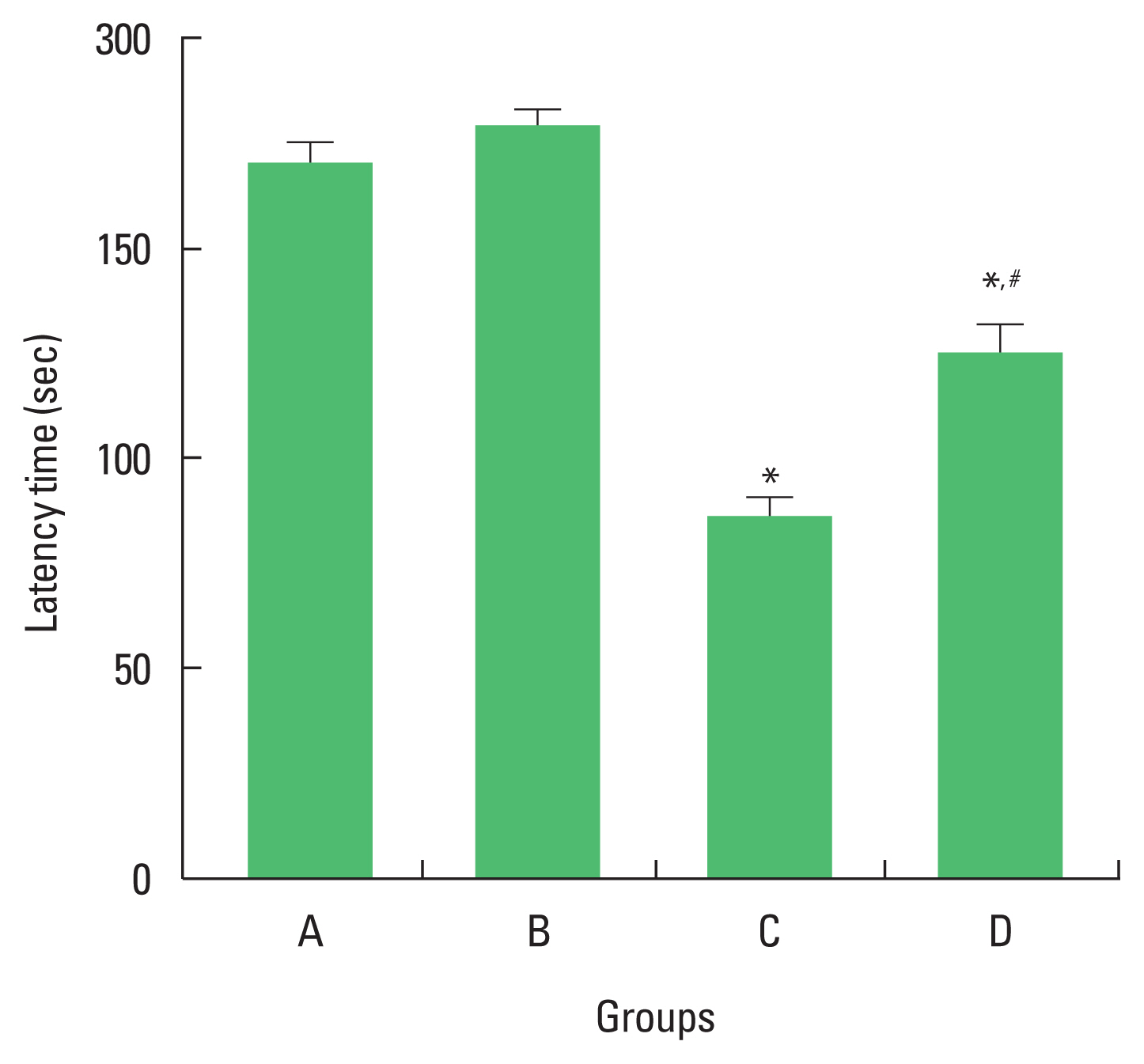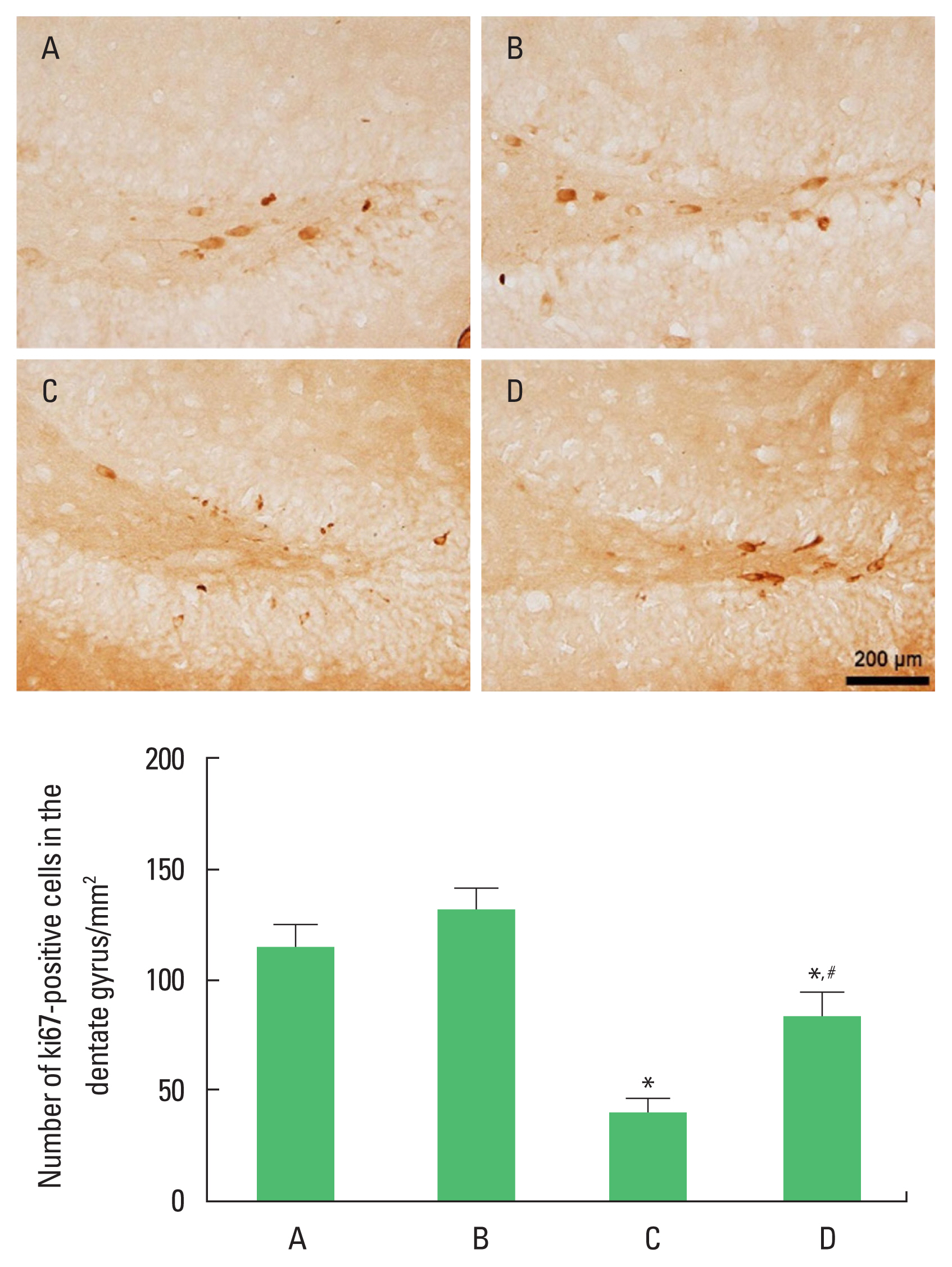INTRODUCTION
Obesity causes atrophy of the brain, leading to deterioration in working memory, learning, and cognitive function. It is known that a high-fat diet reduces the flexibility of synapses in the cerebral cortex, thereby reducing brain function, including the permeability and function of the blood-brain barrier (Arnold et al., 2014).
The hippocampus, which is part of the brain’s limbic system, incorporates many types of memory, especially short-term memory. The hippocampus generates new neurons, which are responsible for the formation and integration of hippocampal-dependent memories (Snyder et al., 2005). The step-down avoidance test was developed to detect short-term memory (Ji et al., 2020). Short-term memory is a capacity that keeps a small amount of information in mind but does not manipulate it while it is active for a short period of time and is readily available.
Apoptosis plays an important role in normal development and tissue homeostasis, which is a form of cell death that eliminates dying cells. However, inappropriate or excessive cell death is closely related to a number of diseases (Lee et al., 2003). Terminal deoxynucleotidyl transferase-mediated dUTP nick end labeling (TUNEL) is a technique that detects DNA fragmentation by labeling 3′-hydroxyl termini in double-strand DNA breaks generating during apoptosis (Gorczyca et al., 1993). TUNEL staining is used to detect DNA fragmentation, which is characteristics of apoptosis. Social isolation in old rats increased TUNEL-positive cell number, indicating that social isolation promoted apoptosis (Park et al., 2020b).
The Ki67 protein is present during all active stages of the cell cycle, such as G1, S, G2, and mitosis, but not in resting cells (G0). The Ki67 protein is markedly increased through the S phase of the cell cycle (Darzynkiewicz et al., 2015). The Ki67 protein is a marker for cellular proliferation (Scholzen and Gerdes, 2000) and Ki67 protein can be used for target protein of immunohistochemistry (Lee et al., 2016). The Ki67 antigen can only be detected within the cell nucleus during interphase, whereas in mitosis, most proteins are rearranged to the chromosomal surface (Cuylen et al., 2016).
In this experiment, the status of short-term memory in rat pups born to older obese mother rats was verified, and the effect of treadmill exercise on short-term memory in rat pups was investigated. Step-down avoidance test for short-term memory, TUNEL staining for apoptosis, and immunohistochemistry for Ki67 for new cell generation were done.
MATERIALS AND METHODS
Animals and classification
This experiment was deliberated by the Animal Care and Use Committee (approval number: 20-135). Sixteen female rats of the 6-week-old Sprague-Dawley family were enrolled. The old female rats were fed with normal diet (5% of fat), and the old and obese female rats were fed with high-fat diet (60% of fat) for up to 50 weeks in age (for 44 weeks in experimental period). For mating, at 46 weeks in age, Sprague-Dawley male rats (15 weeks old) were reared in the same cage for 7 days at the ratio of one female and two males. Female rats were divided into two groups: one group is old rats and the other group is old and obese rats (n=8). Treadmill exercise was performed for a total of 23 weeks, including 20 weeks before induction of pregnancy and 3 weeks of pregnancy. Exercise intensity was performed for 20 min per day at a speed of 5 m/min. The newborn rats were divided into four groups according to the conditions of the mother rats as follows (n=10): the rat pups group born to old rats, the rat pups group born to old rats with exercise, the rat pups group born to old and obese rats, the rat pups group born to old and obese rats with exercise.
Step-down avoidance test
The step-down avoidance test was used to measure short-term memory as explained below (Park et al., 2020a). The rat pups were subjected to a step-down avoidance test after the final treadmill running. The rat pups were sited in a 60×45×25-cm acrylic box with a 7×25-cm platform at the bottom of the box. After placing the rat pup on the platform, the time (latency) until it descended on the floor was measured. When the rat pup came down, a current of 0.5 mA was applied to the sole of the foot for 2 sec. Four hours after training, the latency of each rat was measured. The latency of 300 sec or more was calculated as 300 sec.
TUNEL staining
TUNEL staining by a Cell Death Detection Kit (Roche, Mannheim, Germany) was used as explained below (Park et al., 2020b). The sections were treated with 100 mg/mL proteinase K and TUNEL reaction mixture, and counterstained with Nissl. Air-dry the slides overnight at room temperature and cover slips were used for mounting.
Ki67 immunohistochemistry
Immunohistochemistry for Ki67 was used as explained below (Lee et al., 2016). The sections were treated with mouse anti-caspase-3 antibody (1:500; Santa Cruz Biotechnology, Dallas, TX, USA) overnight and mouse anti-Ki67 antibody (1:500; Novocastra Laboratories, Newcastle, UK). The sections were treated with the biotinylated mouse secondary antibody for another 1 hr. The Vector Elite ABC kit (1:200; Vector Laboratories) was used to amplify the secondary antibody. Air-dry the slides overnight at room temperature and cover slips were used for mounting.
RESULTS
Short-term memory
In the rat pups born to old and obese rats, the latency was suppressed compared to the rat pups group born to old rats. However, rat pups born to old and obese rats with exercise showed increased latency. These results mean that short-term memory was impaired in the rat pups born to old and obese rats, but maternal exercise improved short-term memory of the rat pups born to old and obese rats (Fig. 1).
Apoptosis
In the rat pups born to old and obese rats, the number of TUNEL-positive cells in the hippocampal dentate gyrus was enhanced compared to the rat pups born to old rats. However, rat pups born to old and obese rats with exercise showed decreased number of TUNEL-positive cells. These results mean that apoptosis was increased in the rat pups born to old and obese rats, but maternal exercise inhibited apoptosis of the rat pups born to old and obese rats (Fig. 2).
New cell generation
In the rat pups born to old and obese rats, the number of Ki67 in the hippocampal dentate gyrus was suppressed compared to the rat pups born to old rats. However, rat pups born to old and obese rats with exercise showed increase the number of Ki67. These results mean that new cell generation was decreased in the rat pups born to old and obese rats, however maternal exercise enhanced new cell generation of the rat pups born to old and obese rats (Fig. 3).
DSCUSSION
Obesity in pregnant mothers affects not only the weight at birth of the fetus, but also weight until the age of 4–7, which can be explained because it depends on the supply of nutrition through the fetus or breast milk during the early stages of birth. One study looked at whether older adults had short-term memory deficits. They found that participants aged 55 to 85 had a disability (Fournet et al., 2012).
Performing swimming of maternal rats during pregnancy improved short-term memory by increasing the production of nerve cells in offspring (Lee et al., 2006). Treadmill running during pregnancy improved brain function in offspring (Kim et al., 2007). Short-term memory in pups born to obese rats was impaired, but treadmill exercise during pregnancy improved short-term memory due to increasing neurogenesis in pups born to obese rats (Ji et al., 2020). In the current study, short-term memory was deteriorated in the pups born to old and obese rats, however, maternal exercise improved short-term memory of the pups born to old and obese rats.
In social isolation rats, TUNEL-positive cell number was increased (Park et al., 2020b). Swimming inhibited TUNEL-positive cell number, representing swimming exercise inhibited apoptosis in social isolation-induced apoptosis (Park et al., 2020b). In the current study, apoptosis in the hippocampal dentate gyrus was enhanced in the pups born to old and obese rats, however, maternal exercise suppressed apoptosis of the pups born to old and obese rats.
In autism-induced rat pups, Ki67-positive cell number in the hippocampal dentate gyrus was decreased and short-term memory was impaired (Lee et al., 2016). However, Ki67-positive cell number was enhanced and short-term memory impairment was alleviated in autism-induced rat pups exposed to music (Lee et al., 2016). In the current study, new cell generation in the hippocampal dentate gyrus was suppressed in the pups born to old and obese rats, however, maternal exercise enhanced new cell generation of the pups born to old and obese rats.
In this study, short-term memory was decreased, apoptosis was increased, and the number of new neurons was suppressed in rat pups born from old and obese mother rats. Maternal exercise has been found to contribute to eliminating the health risks of fetuses born to old obese mothers.












